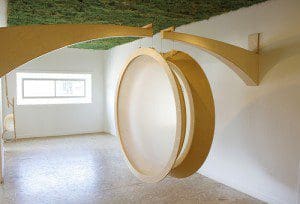
When an artist adopts a particular device as ardently as Yvette Molina has convex circular plates (25 of her 27 works at Johansson Projects’ “circlesaints” exhibition are painted on these), one has to ask, “What is it doing for her art?”
Molina’s works depict scenes of nature in varying states of abstraction. In the best works, the convexity of the surface serves to privilege the abstract over the representational. In the 3-foot in diameter “Akashic Recorders,” for instance, a refracted sun of magnificently unnatural yellow, emitting stylized, geometric lavender rays into the cloud-streaked atmosphere, occupies the bulging center fore; a nub of carefully rendered forest terrain is relegated to the plate’s lower in-curve. In effect, through a kind of misdirection, the piece successfully conveys a sense of wonder toward the natural world.
In other works, the relationship is reversed. The plate’s convexity serves to more emphatically present a representational subject. A recurring image (“Throne,” “Throne Gathering”) is that of a centered tree, rendered saint-like by beatific rays of light emanating from behind it. The effect borders on kitsch, calling to mind decorative plate ware that one might find in a nature preserve gift shop. If it is a sincere attempt to exalt nature, it is trite compared to Molina’s alternate approach. If the religious iconography is in irony, it is hard to see the point.
Michael Meyers’ contributions to “circlesaints,” three sculptural and three drawn works, are somewhat more interesting. The most immediately impressive of them, “Drumscape,” entails two massive “drums” of wood and plastic, studded with bells on the inside, hanging in close adjacency from bowed supports. The elegant construction, perfectly symmetrical with the exception of differing bell patterns, seems as architectural as it is functionless, ultimately resolving into a ritual object – an “alterpiece,” the exhibition catalog suggests.
The provocative, ribbon-like birch sculpture, “Sacra,” continues Meyers’ exploration of symmetry. Unlike the three arrestingly intricate, blueprint-type pattern drawings hanging beside it (“Symmetry I,” “Symmetry II” and “Symmetry III”), “Sacra” does not remain in the abstract. Rather, its supine curvature coalesces into a distinctly well-known form and, to be sure, architectural marvel: the human skeleton (the sacrum is the triangular bone at the base of the spine).
In this sense, both Molina’s and Meyers’ works assume attitudes of reverence toward the natural world. Of course, a good joint exhibition should do more than simply raise comparisons. In this one, though, the ideas at play come to a simmer too early for more fruitful interplay to arise.
circlesaints runs through Dec. 10 at Johansson Projects, 2300 Telegraph Ave., Oakland.
